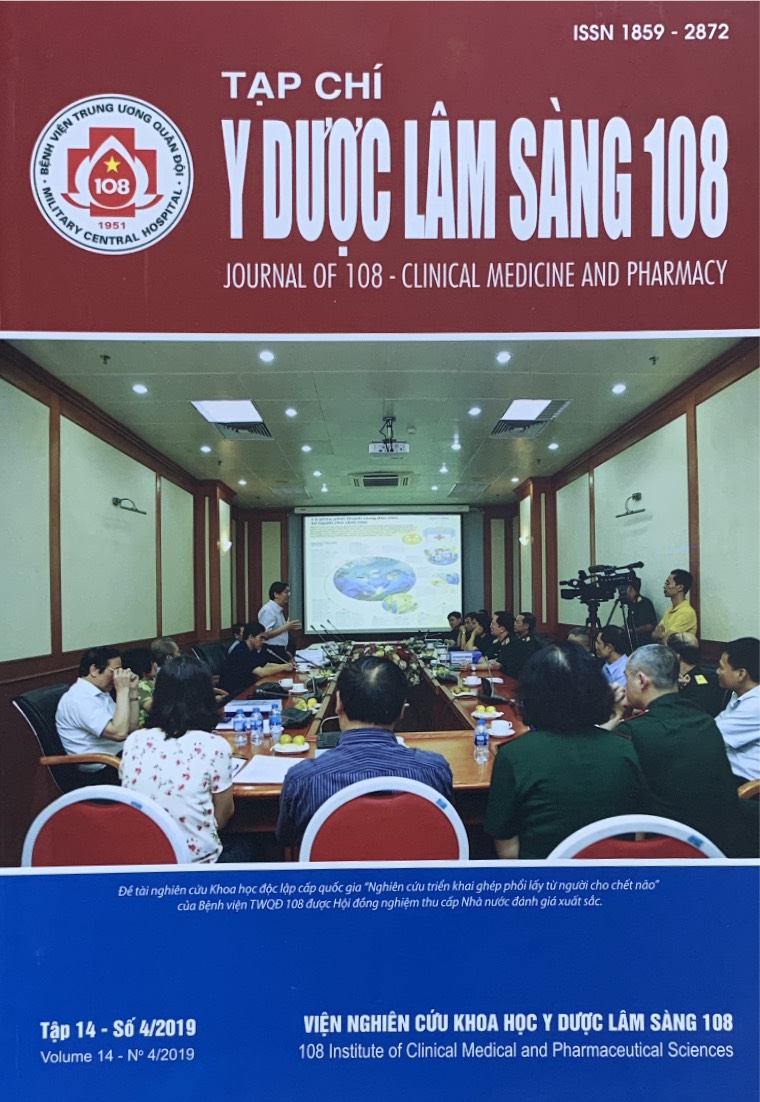Đặc điểm lâm sàng của bệnh nhân ung thư tuyến giáp thể biệt hóa sau phẫu thuật có thyroglobulin cao và xạ hình toàn thân với 131I âm tính
Main Article Content
Keywords
Tóm tắt
Mục tiêu: Nghiên cứu đặc điểm lâm sàng của bệnh nhân ung thư tuyến giáp thể biệt hóa sau phẫu thuật có nồng độ thyroglobulin (Tg) huyết thanh cao và xạ hình toàn thân với 131I âm tính. Đối tượng và phương pháp: Nghiên cứu mô tả cắt ngang trên 109 bệnh nhân ung thư tuyến giáp thể biệt hóa sau phẫu thuật có Tg cao và xạ hình toàn thân với 131I âm tính. Tìm hiểu các đặc điểm lâm sàng, cận lâm sàng và yếu tố nguy cơ tái phát của bệnh nhân. Kết quả: Bệnh nhân ở giai đoạn I (56,9%) và giai đoạn IV (37,6%) với tỷ lệ di căn hạch cổ 74,3%, di căn xa 10,1%. Bệnh nhân có nguy cơ tái phát cao và trung bình chiếm tỷ lệ đa số tương ứng là 53,2% và 40,4%. Nồng độ Tg trung vị và trung bình tương ứng là 217 và 297,9ng/ml. bệnh nhân nam và nguy cơ tái phát cao có nồng độ Tg trung bình cao hơn bệnh nhân nữ và nguy cơ tái phát thấp - trung bình có ý nghĩa thống kê. Siêu âm hạch cổ dương tính ở 62,4% bệnh nhân, trong đó chủ yếu phát hiện hạch cổ nhóm IV và nhóm II. Kết luận: Bệnh nhân ung thư tuyến giáp thể biệt hóa sau phẫu thuật có Tg cao và xạ hình toàn thân với 131I âm tính trong nghiên cứu phần lớn có yếu tố nguy cơ tái phát trung bình - cao và phát hiện hạch cổ nghi ngờ ở nhóm IV và nhóm II trên siêu âm.
Article Details
Các tài liệu tham khảo
2. Basu S, Dandekar M, Joshi A, D'Cruz A (2015) Defining a rational step-care algorithm for managing thyroid carcinoma patients with elevated thyroglobulin and negative on radioiodine scintigraphy (TENIS): Considerations and challenges towards developing an appropriate roadmap. Eur J Nucl Med Mol Imaging 42: 1167-1171.
3. Durante C, Haddy N, Baudin E, Leboulleux S et al (2006) Long-term outcome of 444 patients with distant metastases from papillary and follicular thyroid carcinoma: Benefits and limits of radioiodine therapy. J Clin Endocrinol Metab 91(8): 2892-2899.
4. Ahuja AT, Ying M, Ho SY et al (2008). Ultrasound of malignant cervical lymph nodes. Cancer Imaging 8: 48-56.
5. Na SJ, Yoo IR, O JH et al (2012) Diagnostic accuracy of 18F-fluorodeoxyglucose positron emission tomography/computed tomography in differentiated thyroid cancer patients with elevated thyroglobulin and negative 131I whole body scan: evaluation by thyroglobulin level. Ann Nucl Med 26: 26-34.
6. Vural GU, Akkas BE, Erkamak N et al (2012) Prognostic significance of FDG PET/CT on the follow-up of patients of differentiated thyroid carcinoma with negative 131-I whole-body scan and elevated thyroglobulin levels correlation with clinical and histopathologic characteristics and long-term follow-up data. Clin Nucl Med 37: 953-959.
7. Choi SJ, Jung KP, Lee SS et al (2016) Clinical usefulness of F-18 FDG PET/CT in papillary thyroid cancer with negative radioiodine scan and elevated thyroglobulin level or positive anti-thyroglobulin antibody. Nucl Med Mol Imaging 50: 130-136.
8. Mazzaferri EL, Jhiang SM (1994) Long-term impact of initial surgical and medical therapy on papillary and follicular thyroid cancer. Am J Med 97(5): 418-428.
9. Giovanella L, Trimboli P, Verburg FA et al (2013) Thyroglobulin levels and thyroglobulin doubling time independently predict a positive 18F-FDG PET/CT scan in patients with biochemical recurrence of differentiated thyroid carcinoma. Eur J Nucl Med Mol Imaging 40: 874-880.
10. Bertagna F, Bosio G, Biasiotto G et al (2009) F-18 FDG-PET/CT evaluation of patients with differentiated thyroid cancer with negative I-131 total body scan and high thyroglobulin level. Clin Nucl Med 34: 756-761.
11. Polachek A, Hirsch D, Tzvetov G et al (2011) Prognostic value of post-thyroidectomy thyroglobulin levels in patients with differentiated thyroid cancer. J Endocrinol Invest 34(11): 855-860.
12. Spriano G, Ruscito P, Pellini R et al (2009) Pattern of regional metastases and prognostic factors in differentiated thyroid carcinoma. Acta Otorhinolaryngol Ital 29(6): 312-316.
 ISSN: 1859 - 2872
ISSN: 1859 - 2872
